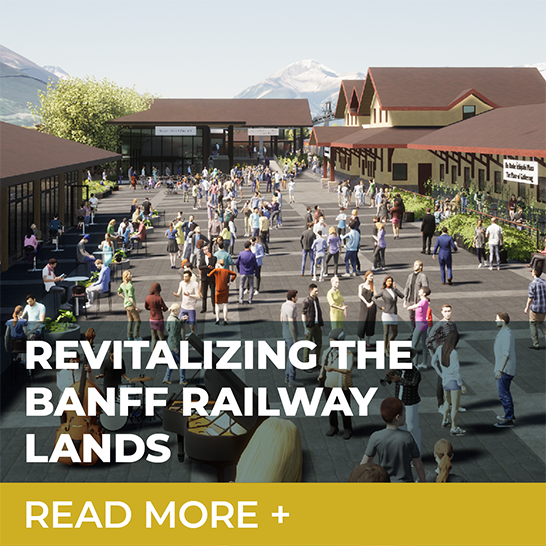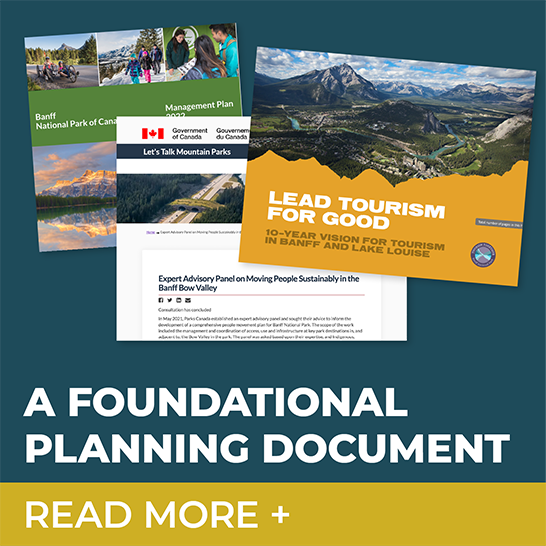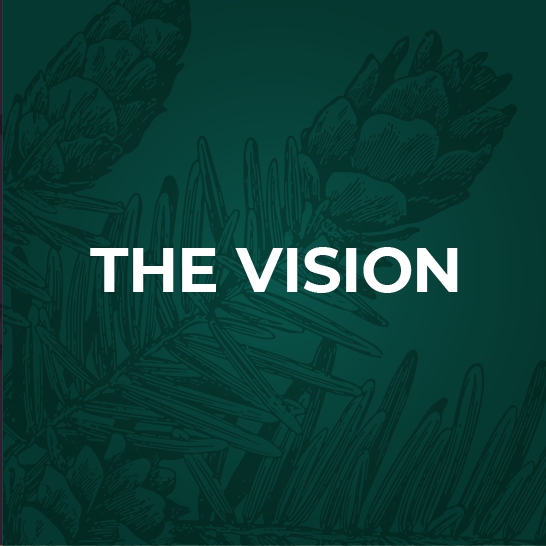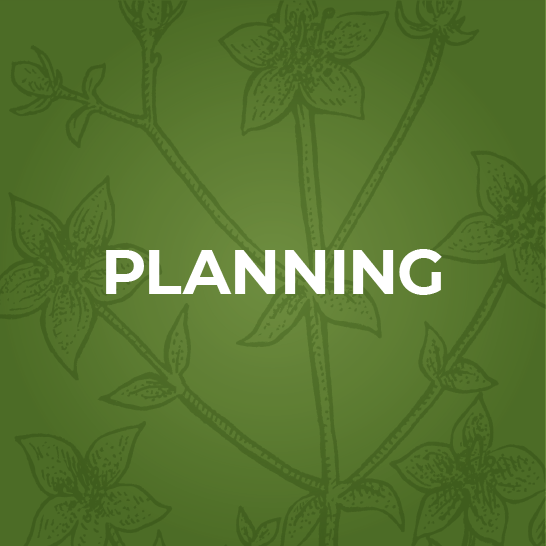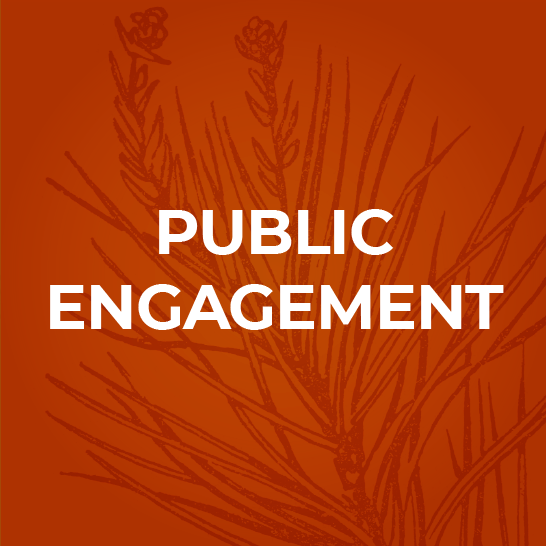
Revitalizing the Banff Railway Lands will change the way people move through Banff National Park and the Town of Banff townsite.
Informed and sustainable solutions such as the Banff Eco-Transit Hub—including intercept parking and potential aspirational projects such as aerial transit to Norquay’s base and passenger rail to Calgary—can create meaningful change.
Learn more about the broader vision for Banff Eco-Transit Hub, the Banff Railway Lands Area Redevelopment Plan, how you can help inform next steps, and much more about this transformative project.
A science-based approach to visitor and
vehicle management in Banff National Park
The Banff Railway Lands ARP keeps moving forward. At yesterday`s Town Council meeting, Council moved the ARP to Second Reading and requested amendments based on community feedback from the Public Hearing. Let`s dive in to what they said ⬇️
🌲Council asked to accelerate the rehabilitation of the conservation area and residential area redevelopment, as well as ensure an environmental assessment for any future development.
🚠 Council has requested edits to Section 5.6 "Norquay Gondola Teminus," where they requested the term `gondola terminus` be deleted to instead include a broader range of multi-modal transportation systems listed in Parks Canada`s Expert Panel on Moving People Sustainably in the Banff Bow Valley. This includes aerial transit, passenger rail, buses, autonomous shuttles, on-demand vehicles, bicycles, and ridesharing services.
🌟 Mayor Corrie DiManno expressed her enthusiasm for the plan, stating, "This is an important moment in Banff`s history, and we have an opportunity to really transform a key gateway into our community. This plan gives us a clear vision to revitalize and rehabilitate this underutilized area. We see the potential to make this a cornerstone of the visitor experience."
Learn more at the link in our bio.

This #EarthDay, we are reminded of our responsibility to help get Banff National Park to net zero.
Learn more about our plan at the link in bio.

A special postcard from the Banff Train Station.
Archives and Special Collections: Byron Harmon Postcards
#banff #canmore #calgary #canada #banffnationalpark #lakelouise #banfftrainstation

Jill Bodkin’s family moved to Banff 65 years ago. After holding positions such as British Columbia’s first female deputy minister, corporate finance partner at Ernst & Young, and director at several private and public organizations, Ms. Bodkin shared her wisdom at the ARP Public Hearing.
Citing examples of other tourist towns that have prioritized ecological integrity, Ms. Bodkin urged Council to take the first step towards a “carless” Banff.
“I know it is possible for a community to create a revitalized experience for residents and visitors. The prerequisites are determined and willing public officials, informed and educated local people willing to work in the interest of their values, and a far-seeing investor, willing to build with the local people, towards prosperity that suits their community.”

Sean O’Farrell is a Director of the Wim & Nancy Pauw Foundation and has worked for Banff Caribou Properties for over 20 years. Sean kicked off the ARP Public Hearing by discussing the history of the Banff Train Station, and the years it stood in a state of disrepair and abandonment. He explained how heritage buildings need purpose and economic viability to thrive.
“The ARP will allow the Train Station and the surrounding lands to have a purpose. The station began as a transportation hub, and it’s only fitting that 100 years later, it continues as one.”

What’s next for the Banff Railway Lands ARP?
1️⃣ On April 22, Banff Town Council will vote on the ARP at “Second Reading.” This begins the process when Council can ask questions that could lead to making amendments to the ARP.
2️⃣ If the ARP passes Second Reading, it moves on to the Third and Final Reading.
3️⃣ If Council passes the bylaw to adopt an ARP, the plan is sent to Parks Canada for review and recommendations to the federal minister overseeing Banff National Park, who has final say on the land use matter.
📲 Subscribe to our newsletter (link in highlights) and keep following this page for more updates.

Katie Tuff is President of the Banff Hospitality Collective and has worked in Banff’s hospitality industry since 2007. At the ARP Public Hearing, Katie spoke about the importance of moving people effectively through Banff’s downtown, and how economic viability is essential for environmental sustainability.
“If we figure out how to differently move human beings into and around Banff’s downtown core and centrally located outdoor experiences, including Norquay, this is the most powerful starting point to protecting wildlife in the remaining 6,500 kilometres of these wild spaces that we call Banff National Park."

Marty Von Neudegg is a born and raised Banffite, who built a successful law career and raised his family in the Bow Valley.
At the ARP Public Hearing, Marty recalled the glory days of the Banff Train Station, the subsequent neglect of the Railway Lands, and his hopes for the future of Banff.
“It’s inexcusable that one of Canada’s most iconic rail stations and railway lands has been treated as no more than an industrial port.
Instead of that, we now have a company that’s looking to create a 100-year plan to enhance these lands, so that my kids won’t be standing here in 50 years, doing an ‘I remember when it was nice speech.’”

The Canadian Pacific Railway passenger train parked at the Banff Train Station in the 1950`s.
What do you think a train from Calgary to Banff would look like today?
#banff #lakelouise #calgary #cpkc #cpr #canada #train #calgarybanffrail #banffnationalpark

Connie MacDonald is a longtime Banff resident who has held senior positions at the Banff Centre, CMH Heli-Skiing, and the YWCA. She is also a strong supporter of the Banff Railway Lands ARP.
At the Public Hearing, Connie spoke about the success of the intercept parking lot, ROAM transit, and the viability of the ARP’s economic model.
“I believe the ARP presents a significant opportunity for us here as the guiding document for the Railway Lands. I believe this is the plan we’ve been waiting for.”

Doug Leighton has spent 40 years as a professional urban planner and was the founding Director of Planning and Development for the Town of Banff in 1989.
Doug came back to town to share his deep support for the Railway Lands ARP at the Public Hearing. He commended the ARP’s public engagement process, heritage preservation, public transportation benefits, and climate change mitigation efforts.
“This is the most comprehensive Area Redevelopment Plan I’ve seen in my career.”

ABOUT US | We’ve gained several new followers on this page recently, so we’d like to re-introduce ourselves.
🌲 The Banff Eco-Transit Hub is a sustainable transportation initiative from the Waterous family, Banff locals who have lived in town since the 1990’s. Jan and Adam Waterous, and their three children, Connor, Riley, and Liam, started this initiative in 2016, after becoming increasingly concerned about ecological integrity, traffic congestion, and parking in the town of Banff.
🚲 Through the Banff Eco-Transit Hub project, the Waterous family is re-imagining the Banff Railway Lands to be an arrival centre for green transit systems – a place for residents and visitors to park their cars and take a bike, bus, or eventually maybe a train or gondola to destinations throughout Banff National Park. The Hub will also be a place for community events, learning opportunities, visitor services, and dining.
📝 The Banff Railway Lands Area Redevelopment Plan (ARP) is the first step in achieving the Banff Eco-Transit Hub. If approved by Town Council this year, the Banff Railway Lands ARP will rehabilitate the Railway Lands and be a catalyst for the larger Banff Eco-Transit Hub initiative.
💡 Learn more about the Banff Eco-Transit Hub and the Waterous family at the link in bio.


